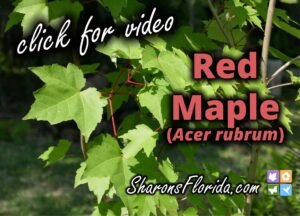
Maple Trees Native to Florida
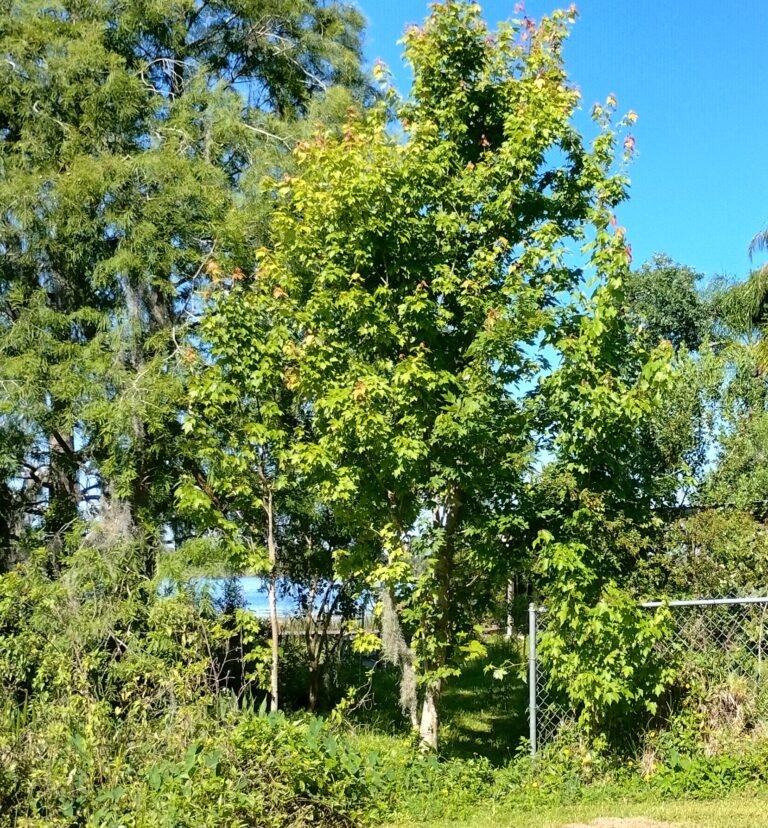
There are five maple trees native to Florida.
- Acer negundo (box elder)
- Acer rubrum (red maple)
- Acer saccharinum (silver maple)
- Acer saccharum ssp. floridanum (Florida maple)
- Acer saccharum ssp. leucoderme (chalk maple)
The maple tree is in the Sapindaceae, or soapberry, family of plants.
Maples used to be in their own family called the Aceraceae family but that has been dissolved and is no longer used.
“The Maple family is dead. For sure there are still plenty of species of maples (Acer) across North America and Asia, but the maple family (Aceraceae) is gone — cut down by a new generation of taxonomists wielding DNA datasets and modern phylogenetic theory. The maples and their close cousins the horse-chestnuts (Hippocastanaceae) are now part of an expanded Soapberry family (Sapindaceae). …” . Source: Fertig, Walter. September 2010 (Volume 33 Number 5). The Maple Family is Dead. SegoLily Newsletter of the Utah Native Plant Society. Utah Native Plant Society. Accessed: 2 June 2024. [https://www.unps.org/segolily/Sego2010SepOct.pdf]
Most literature states that maples are short lived. I suppose their life span of 80-150 years is shorter than some oaks that live to be 400 years of age, but 80–150 years doesn’t seem that short lived to me.
Maples are considered mainly dioecious meaning that male and female flowers are found on separate trees so a particular tree is either female or male. However, some maples can be polygamo-dioecious where they have perfect flowers (bisexual with male and female parts) along with the majority of that tree’s flowers which might be male (staminate) or female (pistillate). To confuse it even further some may also have pistillate, staminate, and perfect flowers on the same tree.
Maple fruit/seeds are called samaras. They have wings that allow them to be carried by the wind like little helicopters.
Most maples can be tapped for collecting their sap to make maple syrup.
There is a botanical key for the Acers (maples) at the end of this article that will give you the tools to positively identify a maple you may be trying to name.
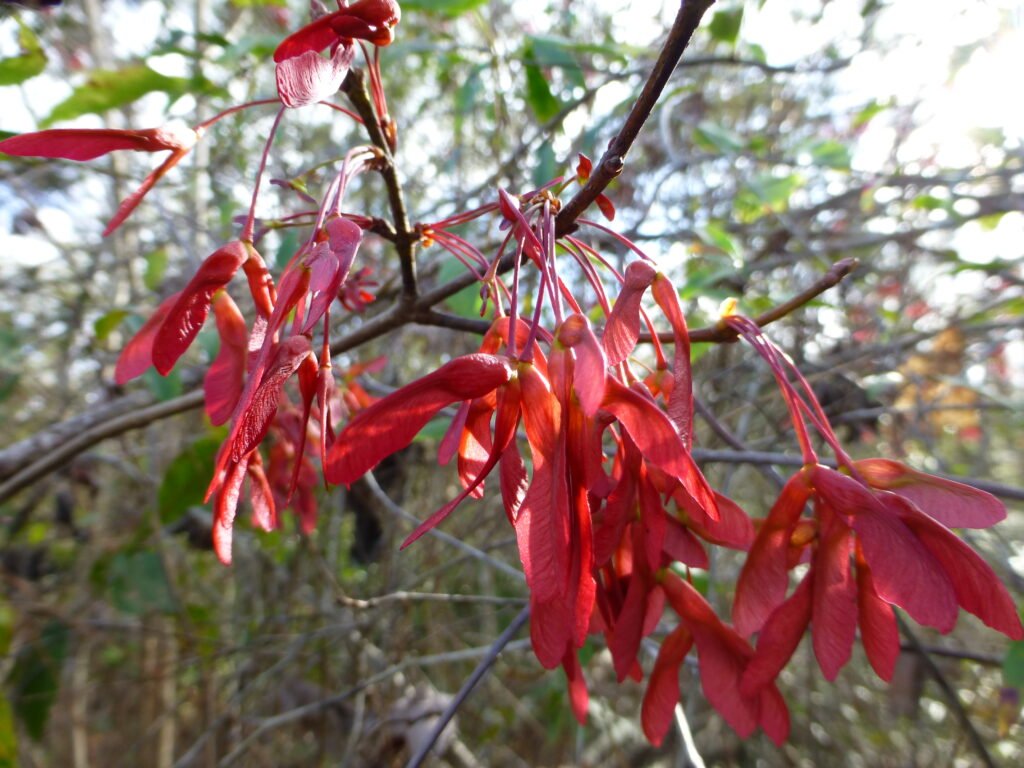
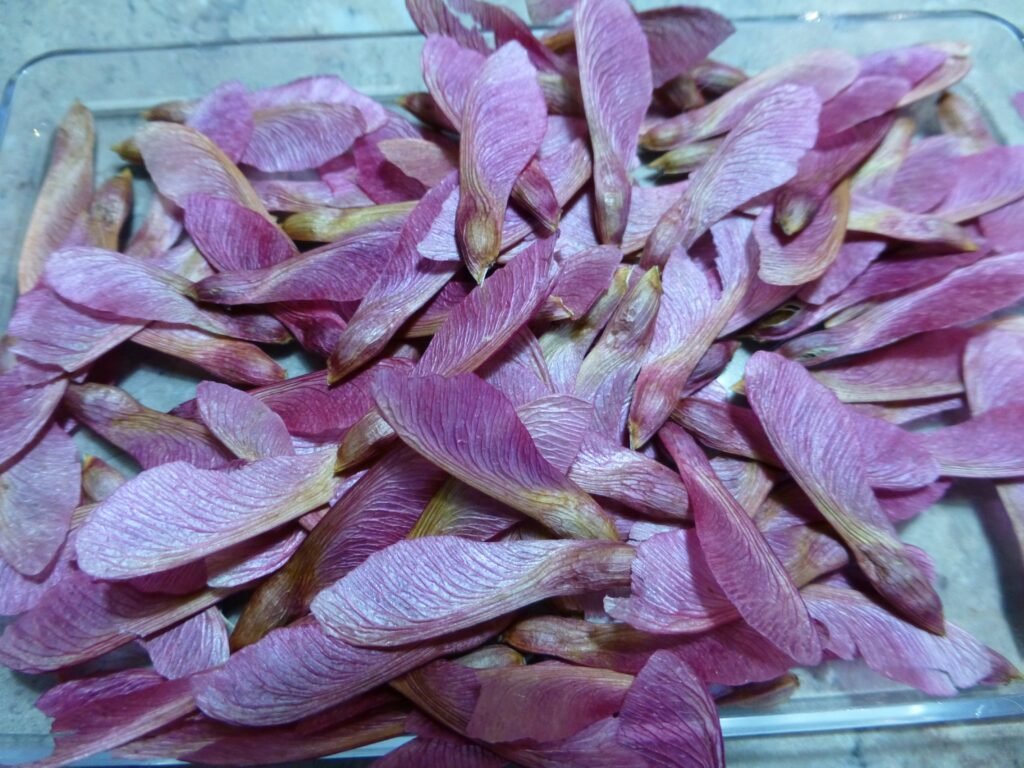
1. Box Elder
(Acer negundo)
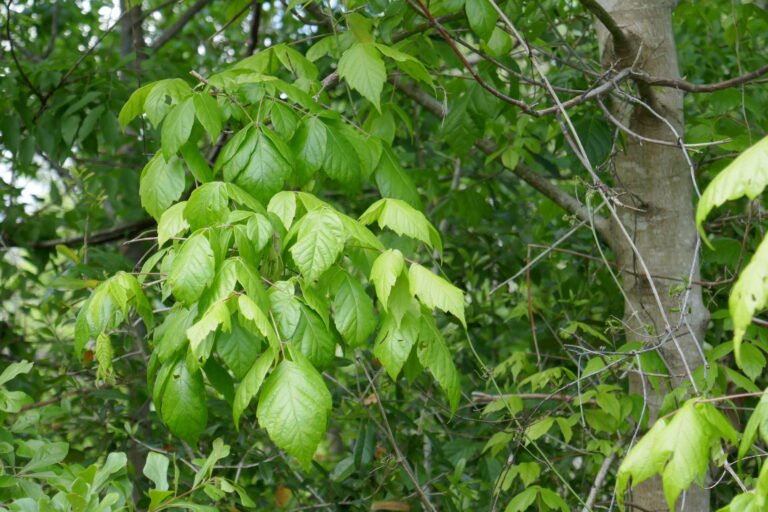
Box Elder Florida Range Map
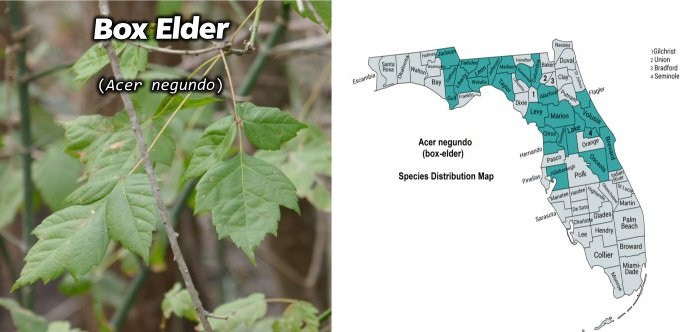
Common Names: Boxelder, box-elder maple, ashleaf maple, ash-leaved maple, and red river maple.
Latin Name: Acer negundo
Form: Boxelder is a medium sized, deciduous, tree that reaches a mature height of 65 feet.
National Champion: The National Champion box elder is in Maryland with a trunk Circumference of: 222 inches, a height of 69 feet and a crown spread of 83.5 feet. [1]
Leaves: The boxelder leaves are compound with long petioles. The leaflets generally number 3-5, but may be found to have nine. They are variable in shape and size.
They range from 2 – 4 inches long and usually the same width. They are ovate to elliptic in shape with some resembling a small red maple leaf. The margins may be toothed or not and lobed or not.
Flowers: The boxelder flowers are small, greenish yellow and are born in clusters. The flowers appear before the leaves emerge in the spring.
Fruit: A double samara. Much of its fruit stay on the tree over winter.
Habitat: Boxelder is found occurring naturally in low, wet forests, stream banks, and flooded bottomland.
Native Range: In Florida it is found in the northern and central part of the state west to the central panhandle.
In the United States it is native to the following states – AL, AR, AZ, CA, CO, CT, DC, DE, FL, GA, IA, ID, IL, IN, KS, KY, LA, MA, MD, ME, MI, MN, MO, MS, MT, NC, ND, NE, NH, NJ, NM, NV, NY, OH, OK, OR, PA, RI, SC, SD, TN, TX, UT, VA, VT, WA, WI, WV, and WY.
Landscape Use: In the home landscape boxelder is grown as a fast growing shade tree, a wildlife habitat tree, and a maple syrup tree.
It can grow in full sun to part shade with moist soils. It can grow in drier conditions if kept watered during periods of drought.
Wildlife Uses: In Central Florida many migrating, and full time resident, birds rely on maple seeds, buds and flowers for food. Specific birds that have been found to rely on maple are the goldfinch, Carolina chickadee, grosbeaks, and yellow-bellied sapsucker.
Sapsuckers consume the syrup and maintain open “wells” in the trees that provide for many other wildlife that love the taste of maple syrup including ruby-throated hummingbirds.
Game birds such as wild turkey and bobwhite quail consume the buds, seeds and twigs.
Many mammals, such as black bear, beaver, rabbit, raccoon, flying squirrels, and gray squirrels, rely on maple as well, and consume the seeds, flowers, bark, and twigs. White tailed deer eat the foliage and young twigs of maple trees. Native mice, and rats, eat and store the seeds. Maple flowers attract bees. [2]
The cecropia silkmoth (Hyalophora cecropia) uses maples as a larval host plant.
Human Uses: Maple syrup has long been used by many people as a sweetener.
“Maple syrup is a natural source of sugar and can be used in many recipes to make yummy treats and foods. The best part is that it is relatively easy to obtain and simple to make. The required components to produce maple syrup include: (1) correct-sized trees in the Acer genus, (2) the right temperatures for sap flow, and (3) the equipment to collect and process sap.” [3]
Boxelder Footnotes:
[1] Godfrey, R.K., and J.W. Wooten. Trees, Shrubs, and Woody Vines of Northern Florida and Adjacent Georgia and Alabama. University of Georgia Press: Athens, GA 1981. Print. https://amzn.to/4aTtwjj – Sharons Florida Amazon Associate link
[2] Alexander C. Martin, Herbert S. Zim, et al.. American Wildlife and Plants: A Guide To Wildlife Food Habits. Oct 5, 2011. Print. https://amzn.to/3QmaDxh – Sharons Florida Amazon Associate link
[3] Mathews, Jesse. et al., April 2023. Producing Maple Syrup From Boxelder and Norway Maple Trees. Utah State University Extension. Accessed: 1 May 2024. [https://extension.usu.edu/forestry/files/publications/utah-forest-facts/043-producing-maple-syrup.pdf]
2. Red Maple
(Acer rubrum)
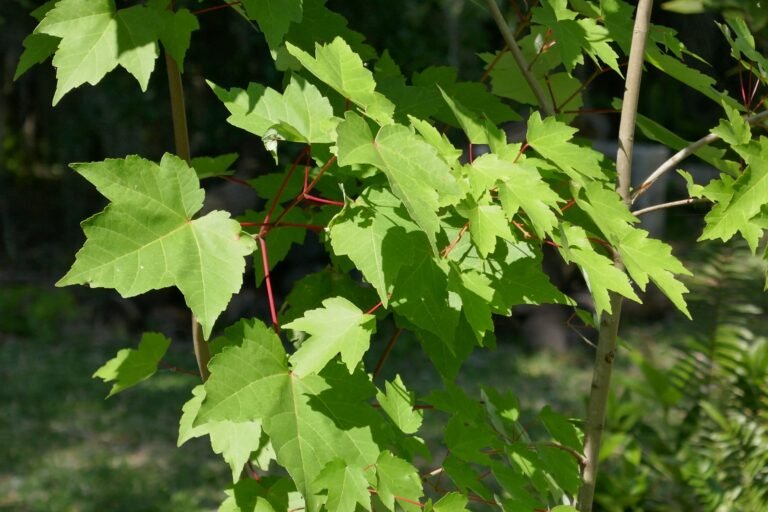
Red Maple Florida Range Map
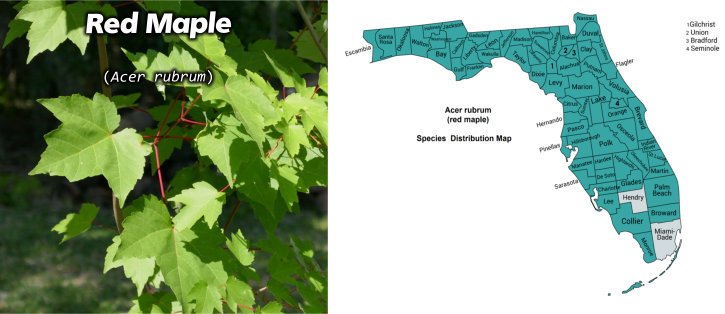
Common Names: Carolina red maple, scarlet maple, soft maple, swamp maple, water maple, and white maple.
Latin Name: Acer rubrum
Form: Red maple is a large deciduous, tree that reaches a mature height of 100 feet in ideal conditions.
Less ideal settings produce trees that grow to 60 to 90 feet. Red maple has root adaptability that allows it to adapt to almost any soil type and moisture. In dry settings it sends roots deep into the ground for water, and in wetter conditions it grows more shallow roots. This adaptability allows it to grow very fast.
The brilliant red fruit, samaras, make this tree stand out in the late fall and early winter landscape.
National Champion Tree: The National Champion red maple (as of 2019), located in New Haven County CT measures 72 feet high, 68 foot crown spread, 276 inches in circumference and scores 365 points. Source: [https://www.americanforests.org/tree/red-maple-ct/]
The Florida Champion red maple is known as Ace and grows in the Green Swamp in Polk County, Florida.
Ace has a height of 103 feet, circumference of 166 inches and crown spread around 76 feet. These three measurements are used to award a point total to trees in the register. Ace’s measurements earned enough points to edge out the previous red maple Florida Champion, a 102-foot red maple in Citrus County. [1]
Leaves: Red maple leaves are simple, and opposite with red petioles. The leaf size can vary from 2 – 6 inches long and 2 – 4 inches wide. The margins are serrate. The upper leaf surface is green and the lower is gray-white. They are ovate to elliptic in shape with some resembling a small red maple leaf. The margins may be toothed or not and lobed or not.
Flowers: Red maple flowers are tiny, red, and appear in late winter before the leaves emerge.
Fruit: Red maple fruit is a red, winged, seed known as a samara. Red maples have double samaras. The wings allow them to get carried by the wind in a helicopter fashion.
Habitat: It occurs naturally in moist forests, swamps, and riparian areas.
Native Range: In Florida red maple is found naturally occurring throughout the state with the exception of Miami-Dade and Hendry Counties.
In the United States red maple is native to the following states – AL, AR, CT, DC, DE, FL, GA, IA, IL, IN, KY, LA, MA, MD, ME, MI, MN, MO, MS, NC, NH, NJ, NY, OH, OK, PA, RI, SC, TN, TX, VA, VT, WI, and WV.
Landscape Use: In the home landscape red maple is grown as a fast growing shade tree, a wildlife habitat tree, and a maple syrup tree.
It can grow in full sun to part shade with moist to wet soils. It does not tolerate standing water for long periods of time.
It can be grown in drier conditions if kept watered during periods of drought.
Wildlife Uses: In Central Florida many migrating, and full time resident, birds such as the goldfinch, Carolina chickadee, grosbeaks, and yellow-bellied sapsucker, rely on maple seeds, sap, buds, flowers, and foliage for food as well as nest building materials.
Sapsuckers consume the syrup and maintain open “wells” in the trees that provide for many other wildlife that love the taste of maple syrup including ruby-throated hummingbirds. [2]
Game birds such as wild turkey and bobwhite quail consume the buds, seeds and twigs.
Many mammals, such as black bear, beaver, rabbit, raccoon, flying squirrels, and gray squirrels, rely on maple as well, and consume the seeds, flowers, bark, and twigs. White tailed deer eat the foliage and young twigs of maple trees. Native mice, and rats, eat and store the seeds. Maple flowers attract bees. [3]
The cecropia silkmoth (Hyalophora cecropia) uses maples as a larval host plant.
Human Uses: Maple syrup has long been used by many people as a sweetener.
“Maple syrup is a natural source of sugar and can be used in many recipes to make yummy treats and foods. The best part is that it is relatively easy to obtain and simple to make. The required components to produce maple syrup include: (1) correct-sized trees in the Acer genus, (2) the right temperatures for sap flow, and (3) the equipment to collect and process sap.” [4]
Red Maple Footnotes:
[1] November–December 2012 District Tree Named Florida Champion. Southwest Florida Water Management District. 1 May 2024. [https://www.swfwmd.state.fl.us/blog/watermatters-magazine/56/district-tree-named-florida-champion#:~:text=Ace%2C%20short%20for%20its%20scientific,species%20in%20the%20United%20States]
[2] Deinlein, Mary. August 15, 2003 The Master Sap Tapper. Smithsonian’s. National Zoo & Conservation Biology Institute. 1 May 2024. [https://nationalzoo.si.edu/migratory-birds/news/master-sap-tapper]
[3] Alexander C. Martin, Herbert S. Zim, et al.. American Wildlife and Plants: A Guide To Wildlife Food Habits. Oct 5, 2011. Print. [https://amzn.to/3QmaDxh – Sharons Florida Amazon Associate link]
[4] Mathews, Jesse. April 2023. Producing Maple Syrup From Boxelder and Norway Maple Trees. Utah State University Extension. Accessed: 1 May 2024. [https://extension.usu.edu/forestry/files/publications/utah-forest-facts/043-producing-maple-syrup.pdf]
3. Silver Maple
(Acer saccharinum)
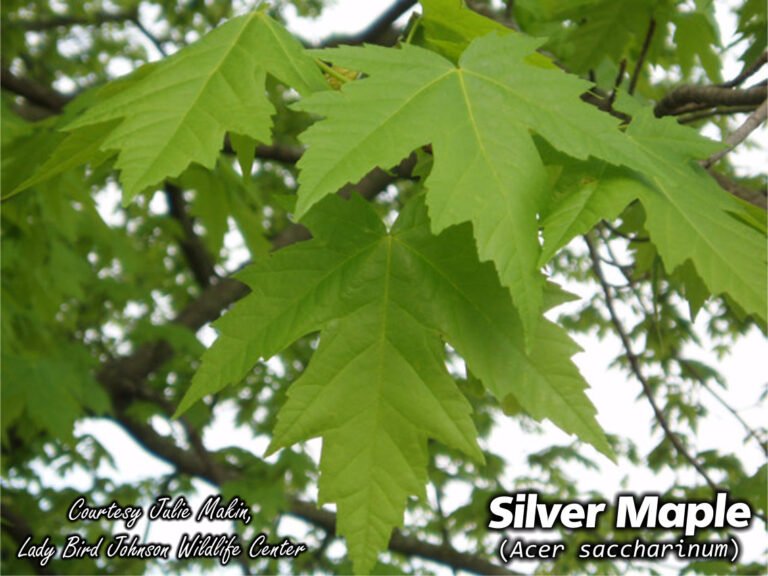
Silver Maple Florida Range Map
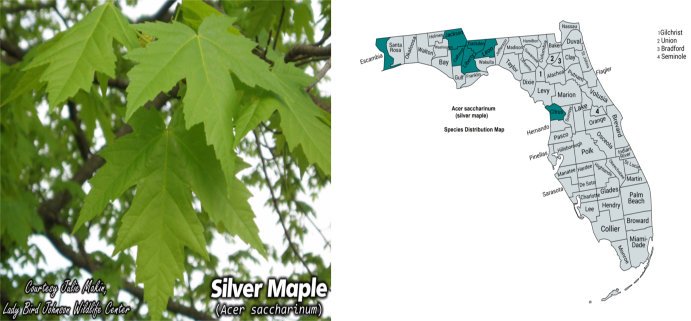
Common Names: Silver maple, soft maple, and white maple.
Latin Name: Acer saccharinum
Form: Silver maple is a large deciduous tree that reaches a height of 125 feet at maturity.
National Champion Tree: The National Champion silver maple is in Minnesota and the trunk circumference is 381.6 inches. And the height is 96 feet with a 95 foot crown spread. [1]
Leaves: The silver maple’s leaves are opposite, simple, with sharply serrate margins.
The size varies from 2 1/2 to 8 inches long. The upper leaf surface is green with the lower being silvery.
The leaves are five-lobed and produce beautiful fall colors.
Flowers: The small flowers are greenish yellow and appear in the early spring before the leaves emerge.
It is dioecious with the male and female flowers on separate trees.
Fruit: A two-winged samara that is green turning brown as it ripens.
Habitat: Silver maple is found occurring naturally along riverbanks, moist hillsides, and low wet forests.
Native Range: In Florida it is found in Citrus County, and in a handful of counties in the panhandle.
It is native to the following states: AL, AR, CT, DC, DE, FL, GA, IA, IL, IN, KS, KY, LA, MA, MD, ME, MI, MN, MO, MS, NC, ND, NE, NH, NJ, NY, OH, OK, PA, RI, SC, SD, TN, VA, VT, WI, and WV.
Landscape Use: Silver maple grows best in moist soils with full sun. Planting in open areas where other trees are not competing for sunlight is best and will allow the tree to grow faster. The roots can be aggressive so it is best not planted near foundations or septic systems.
It can grow in drier conditions if kept watered during periods of drought.
Silver maple has exceptional fall leaf color which is one of its desirable features for landscaping. It is a fast growing shade tree, and provides food for wildlife and can be tapped for maple syrup for human use.
It is a large tree so make sure you have room for it to grow to its potential.
Wildlife Uses: In Central Florida many migrating, and full time resident, birds such as the goldfinch, Carolina chickadee, grosbeaks, and yellow-bellied sapsucker, rely on maple seeds, sap, buds, flowers, and foliage for food as well as nest building materials.
Sapsuckers consume the syrup and maintain open “wells” in the trees that provide for many other wildlife that love the taste of maple syrup including ruby-throated hummingbirds.
Game birds such as wild turkey and bobwhite quail consume the buds, seeds and twigs.
Many mammals, such as black bear, beaver, rabbit, raccoon, flying squirrels, and gray squirrels, rely on maple as well, and consume the seeds, flowers, bark, and twigs. White tailed deer eat the foliage and young twigs of maple trees. Native mice, and rats, eat and store the seeds. Maple flowers attract bees. [2]
The cecropia silkmoth (Hyalophora cecropia) uses maples as a larval host plant.
Human Uses: “Of the 13 native North American maple species, sugar maple (Acer saccharum L.) and black maple (A. nigrum Michx. f.) are the most preferred for commercial tapping. … [paragraph 1]
Silver maple (A. saccharinum L.), with a greater natural range than sugar or black maple, is infrequently tapped for maple syrup production. This is largely attributed to its’ lower average SSC (1.5 to 2.0 percent) and a shorter collection season due to earlier spring budbreak, compared to sugar and black maple (Walters 1982, Heiligmann and Winch 1996). … [paragraph 3]
… Silver maple grows rapidly on a variety of sites and can be readily propagated through vegetative means. Consequently, silver maple offers great promise as a species that could be integrated into sustainable forest product systems on marginal agricultural or in riparian filters to provide tangible ecological and economic benefits to landowners. …” [Conclusion] [3]
Propagation: It can be grown from seed, cuttings and transplants.
Maple seeds require a period of warm-moist stratification followed by cool stratification although some germination is possible with freshly fallen seeds.
Cuttings should be made from the tip of the branches, or “softwood cuttings” and best results are achieved if dipped in rooting hormone. Silver maple cuttings have much more success than many other species.
Saplings can be transplanted at just about any size if kept watered until established and recovered from the shock.
Silver Maple Footnotes:
[1] Godfrey, R.K., and J.W. Wooten. Trees, Shrubs, and Woody Vines of Northern Florida and Adjacent Georgia and Alabama. University of Georgia Press: Athens, GA 1981. Print. [https://amzn.to/4aTtwjj] Sharons Florida Amazon Associate link
[2] Alexander C. Martin, Herbert S. Zim, et al.. American Wildlife and Plants: A Guide To Wildlife Food Habits. 2011. Print. [https://amzn.to/3QmaDxh] Sharons Florida Amazon Associate link
[3] Zaczek, J. & Carver, Andrew & Williard, Karl & Buchheit, J. & Preece, John & Mangun, Jean. 2003. Sap Sugar Parameters of Silver Maple Provenances and Clones Grown on Upland and Bottomland Sites. Research Gate. Accessed: 1 May 2024. [https://www.researchgate.net/publication/237405062_SAP_SUGAR_PARAMETERS_OF_SILVER_MAPLE_PROVENANCES_AND_CLONES_GROWN_ON_UPLAND_AND_BOTTOMLAND_SITES]
4. Florida Maple
(Acer saccharum ssp. floridanum)
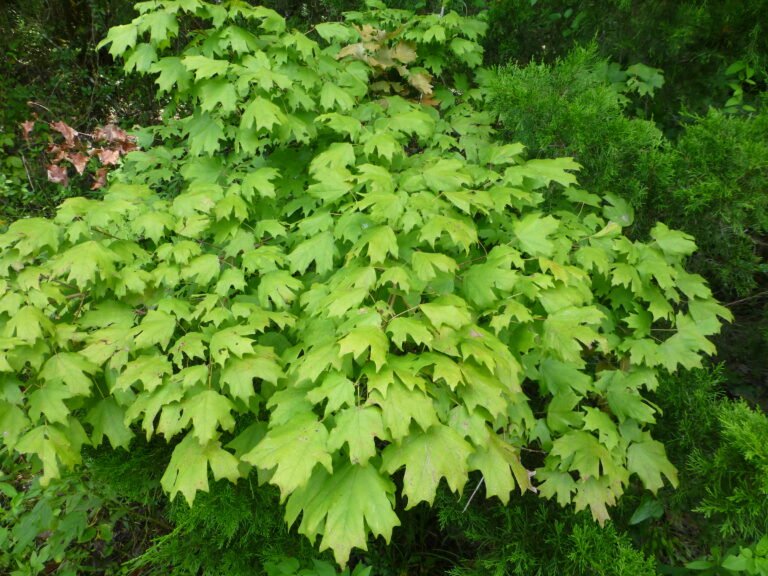
Florida Maple Florida Range Map
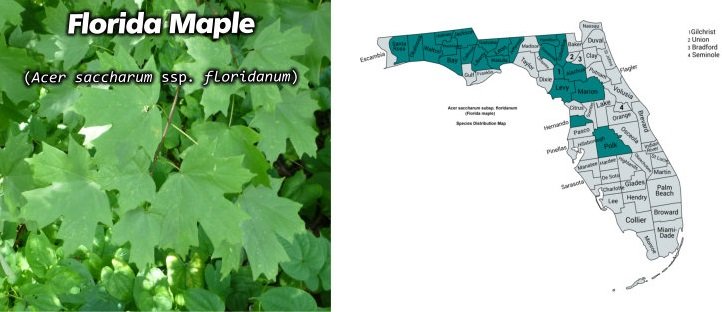
Common Names: Florida maple, southern sugar maple, hammock maple, and rock maple.
Latin Name: Acer saccharum ssp. floridanum. Previously known as Acer barbatum
Form: Florida maple is a medium sized tree that grows to a mature height of 60 feet.
National Champion Florida Maple Tree: Co-national champion Florida maples (1981) 8’10” circumf., 110′ in height, 60′ spread, Sumter Co., Ala; (1981) 7’5″ circumf., 126′ in height, 57′ spread, Stevens Creek Natural Area, S.C.. [1]
Leaves: Opposite, simple, with squarish lobes. They are 2 to 4 inches long and wide. Some lobes may contain smaller lobes. The upper leaf surface is green and the lower is whitish.
Flowers: Florida maple flowers are small and greenish appearing in the spring.
It is dioecious with the male and female flowers on separate trees.
Fruit: The fruit are double samaras that are green and turn to brown as they ripen.
Habitat: It occurs naturally in wooded bluffs, ravines, mesic forests, and rocky slopes.
Native Range: In Florida it is documented for Polk County northward.
It is native to the following states: AL, AR, FL, GA, IL, LA, MO, MS, NC, SC, TN, TX, and VA.
Landscape Use: The Florida maple can be found growing in much drier conditions compared to most maples so it does not have to be grown in a wet site as do most maples. It likes rocky soil so rich soil for planting it in is not necessary. It can be used in problem areas where the terrain is rocky and difficult to maintain.
Wildlife Uses: In Central Florida many migrating, and full time resident, birds such as the goldfinch, Carolina chickadee, grosbeaks, and yellow-bellied sapsucker, rely on maple seeds, sap, buds, flowers, and foliage for food as well as nest building materials.
Sapsuckers consume the syrup and maintain open “wells” in the trees that provide for many other wildlife that love the taste of maple syrup including ruby-throated hummingbirds.
Game birds such as wild turkey and bobwhite quail consume the buds, seeds and twigs.
Many mammals, such as black bear, beaver, rabbit, raccoon, flying squirrels, and gray squirrels, rely on maple as well, and consume the seeds, flowers, bark, and twigs. White tailed deer eat the foliage and young twigs of maple trees.
Native mice and rats eat, and store, the seeds.
Maple flowers attracts bees. [2]
The cecropia silkmoth (Hyalophora cecropia) uses maples as a larval host plant.
Human Uses: There aren’t many articles that discuss using Florida maple for syrup, but it can be done. Sugar maple (Acer saccharum) is the most sought after maple tree for syrup. The Florida maple is a subspecies of that maple. So I would say it’s worth a shot to try it.
Here’s a link to a tutorial on making your own maple syrup if you have access to large Florida maple trees and want to give it a go. Mathews, Jesse., et al., Producing Maple Syrup From Boxelder and Norway Maple Trees. Utah State University. 1 May 2024. [https://extension.usu.edu/forestry/files/publications/utah-forest-facts/043-producing-maple-syrup.pdf]
Propagation: Florida maple can be grown from seed, cuttings and transplants.
Maple seeds require a period of warm-moist stratification followed by cool stratification although some germination is possible with freshly fallen seeds. The outer coating of the samara does not need to be removed.
Cuttings should be made from the tip of the branches, or “softwood cuttings” and best results are achieved if dipped in rooting hormone. Silver maple cuttings have much more success than many other species.
Saplings can be transplanted at just about any size if kept watered until established and recovered from the shock.
Florida Maple Footnotes:
[1] Godfrey, R.K., and J.W. Wooten. Trees, Shrubs, and Woody Vines of Northern Florida and Adjacent Georgia and Alabama. University of Georgia Press: Athens, GA 1981. Print. [https://amzn.to/4aTtwjj] Sharons Florida Amazon Associate link
[2] Alexander C. Martin, Herbert S. Zim, et al.. American Wildlife and Plants: A Guide To Wildlife Food Habits. 2011. Print [https://amzn.to/3QmaDxh] Sharons Florida Amazon Associate link
5. Chalk Maple
(Acer saccharum ssp. leucoderme)
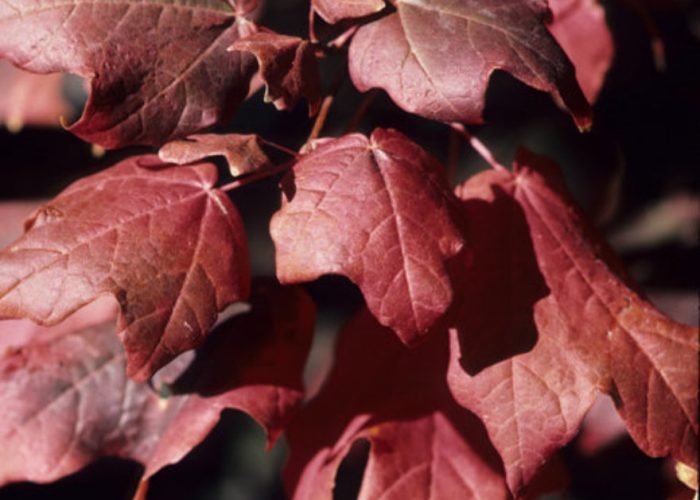
Chalk Maple Florida Range Map
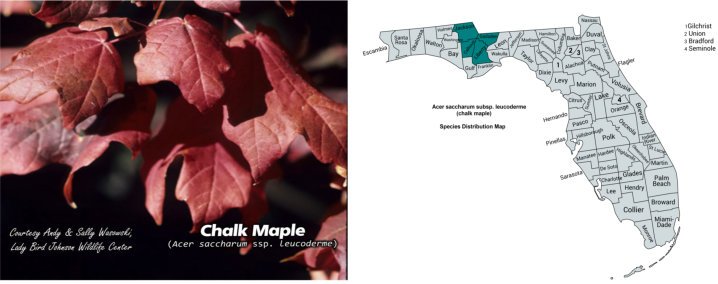
Common Names: Chalk maple and white-barked sugar maple.
Latin Name: Acer Acer saccharum ssp. leucoderme
Form: Chalk maple is a deciduous tree that reaches a height of 20 feet at maturity. It is the smallest of our native maple trees.
National Champion Chalk Maple Tree: Co-national champion chalk maples (1981), 2’7″ circumf., 30′ in height, 40′ spread, Clemson University Forest, S.C.; (1981) 2’3″ circumf., 35′ in height, 34′ spread, Pickens Co., S.C.. [1]
Leaves: Chalk maple leaves are opposite and simple with 3 to 5 lobes. The lobes are tapered upward from the base. The tips are more pointed than the Florida maple.
The upper surface of the leaf is green and the underside is a pale green.
Flowers: Small yellow flowers appear in the spring just as the leaves begin to appear.
Fruit: The fruit is a double samara, but smaller than other maples. The wings spread broadly and are a brownish red when ripe.
Habitat: Chalk maple grows in dry conditions such as bluffs and upland calcareous forests.
Native Range: Chalk maple is only found in the panhandle of Florida. It has been documented for Calhoun, Gadsden, Jackson, and Liberty counties.
It is native to the following states: AL, AR, DC, FL, GA, LA, MS, NC, OK, SC, TN, and TX.
Landscape Use: Chalk maples are used for landscaping to provide shade and wildlife habitat, for maple syrup production and occasionally for bonsai specimens.
Since they only grow to 20 feet they can be used in many locations that would be too small for most other maples. They can also be grown in drier conditions than most maples, but if heat stressed they will require regular irrigation.
Wildlife Uses: In Central Florida many migrating, and full time resident, birds such as the goldfinch, Carolina chickadee, grosbeaks, and yellow-bellied sapsucker, rely on maple seeds, sap, buds, flowers, and foliage for food as well as nest building materials.
Sapsuckers consume the syrup and maintain open “wells” in the trees that provide for many other wildlife that love the taste of maple syrup including ruby-throated hummingbirds.
Game birds such as wild turkey and bobwhite quail consume the buds, seeds and twigs.
Many mammals, such as black bear, beaver, rabbit, raccoon, flying squirrels, and gray squirrels, rely on maple as well, and consume the seeds, flowers, bark, and twigs. White tailed deer eat the foliage and young twigs of maple trees. Native mice, and rats, eat and store the seeds. Maple flowers attract bees. [2]
The cecropia silkmoth (Hyalophora cecropia) uses maples as a larval host plant.
Human Uses: Considering the small size of these trees I am unsure of the ability to tap them for sap. With that being said the National Champion chalk maple is 30′ in height so that’s a pretty large tree. It may be worth attempting to collect sap from them.
Propagation: It can be grown from seed, cuttings and transplants.
Maple seeds require a period of warm-moist stratification followed by cool stratification although some germination is possible with freshly fallen seeds. The outer coating of the samara does not need to be removed.
Cuttings should be made from the tip of the branches, or “softwood cuttings” and best results are achieved if dipped in rooting hormone. Silver maple cuttings have much more success than many other species.
Saplings can be transplanted at just about any size if kept watered until established and recovered from the shock.
Chalk Maple Footnotes:
[1] Godfrey, R.K., and J.W. Wooten. Trees, Shrubs, and Woody Vines of Northern Florida and Adjacent Georgia and Alabama. University of Georgia Press: Athens, GA 1981. Print. [https://amzn.to/4aTtwjj] Sharons Florida Amazon Associate link
[2] Alexander C. Martin, Herbert S. Zim, et al.. American Wildlife and Plants: A Guide To Wildlife Food Habits. 2011. Print. [https://amzn.to/3QmaDxh] Sharons Florida Amazon Associate link
